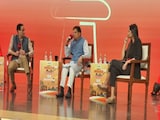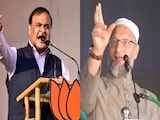- India's astronaut Shubhanshu Shukla is midway through the 14-day Axiom 4 mission at the ISS
- The mission includes seven scientific experiments on space biology and sustainability
- Experiments involve sprouting Indian crops and studying cyanobacteria for life support
India is poised to mark a historic milestone in its space exploration journey as an Indian astronaut, Shubhanshu Shukla, or Gaganyatri, completes more than half his mission at the International Space Station (ISS) aboard the Axiom 4 mission, launched via SpaceX's Falcon 9 Crew Dragon.
This 14-day mission, a collaboration between ISRO, NASA, and Axiom Space, sees the astronaut conduct seven scientific experiments that could help in future of space biology and sustainability in long-duration missions.
In an exclusive conversation with NDTV, NASA biologist Dr Sharmila Bhattacharya, and a guest speaker at the Ashoka University, shared detailed insights into some of the Indian experiments and their significance. Dr Bhattacharya, who has flown at least nine experiments on the ISS and trained astronauts, including Sunita Williams, expressed her excitement about India's growing role in space science.
Recently, on July 4, ISRO gave an update suggesting that 'Gaganyatri has successfully completed the microgravity experiment involving Tardigrades on board ISS.' In addition, ISRO aims to inspire students and the public by bringing the experience of space closer to Earth through its outreach activities. The microgravity environment provides a great tool to demonstrate scientific principles. During this mission, the Gaganyatri is also conducting science demonstrations on board the ISS, as part of ISRO's planned scientific outreach activity.
Sprouting Indian Nutrition in Space
One of the most anticipated experiments is titled "Sprouts," led by Dr Ravikumar Hosamani, a former postdoctoral fellow in Dr Bhattacharya's lab. This experiment involves sprouting two culturally and nutritionally significant Indian plants-fenugreek (methi) and green gram (moong dal)-in microgravity. These plants were chosen for their high nutritional value and potential health benefits, including support for bone density, cardiovascular health, and immune function.
"These seeds will be sprouted in space, returned to Earth, and analysed for how they responded to the space environment," said Dr Bhattacharya. "This is the first time these specific seeds are being flown, and the data could be invaluable for future space diets."
Although the astronaut won't be consuming the sprouts during the mission, the experiment will assess microbial growth and viability, paving the way for future edible space crops.
Crop Seeds and Space Agriculture
Another experiment, "Crop Seeds on ISS," is being led by Dr Kumaran Sreejalekshmi from the Indian Institute of Space Science and Technology (IIST) in Kerala. This study will expose various Indian crop seeds to the space environment and analyse their germination and growth upon return.
While similar studies have been conducted by NASA, ESA, and China, Dr Bhattacharya emphasised the importance of repeating such experiments with region-specific crops. "The more data we gather, especially with seeds relevant to Indian diets, the better we can prepare for sustainable agriculture in space," she noted.
Cyanobacteria And Microalgae: Life Support And Beyond
Two additional experiments will explore the use of cyanobacteria and microalgae-organisms known for their ability to photosynthesise and produce oxygen. These studies aim to evaluate their potential in environmental control and life support systems (ECLSS) aboard spacecraft.
"Cyanobacteria can help regulate oxygen and carbon dioxide levels, while microalgae could serve as both a food supplement and a source of biofuel," explained Dr Bhattacharya. "Understanding how these organisms behave in space is crucial for long-term missions."
Myogenesis: Studying Muscle Loss in Space
The "Myogenesis" experiment will investigate muscle cell degradation in microgravity. Muscle loss is a well-documented challenge for astronauts, and this study aims to identify biological changes and potential countermeasures.
"In vitro studies allow us to examine cellular responses in detail, which is not always possible with human subjects," said Dr Bhattacharya. "This research could inform exercise routines, dietary supplements, or medications to mitigate muscle loss."
Visual-Motor-Spatial Adaptation
Another experiment will focus on how astronauts' visual and spatial orientation is affected by prolonged exposure to microgravity. Using computer display screens and specialised algorithms, the study will monitor changes in perception and coordination.
"Even though astronauts are highly capable, subtle changes in visual-motor function can occur," said Dr Bhattacharya. "This experiment will help us understand and possibly improve how astronauts interact with digital systems in space."
A Personal Connection to India's Space Journey
Dr Bhattacharya shared a personal anecdote about training Sunita Williams in 2004, long before Williams became a household name in space exploration. "She was in my class of four astronauts, and we spent a month together in Woods Hole, Massachusetts. We've stayed in touch ever since," she said warmly.
Williams, known for her love of Indian food and dubbed the "samosa-eating astronaut," exemplifies the deep cultural and scientific ties between India and NASA.
Building Toward India's Space Future
These experiments are not just isolated studies-they are stepping stones toward India's broader ambitions, including establishing its space station and sending an astronaut to the Moon by 2040, as envisioned by Prime Minister Narendra Modi.
"Doing science in space is not easy," Dr Bhattacharya emphasised. "You need approvals, safety checks, and efficient use of mass, volume, and power. But these baby steps by India are essential. The more data we gather now, the better prepared we'll be for future missions."
She praised the collaborative nature of the Axiom 4 mission, calling it a model for international cooperation. "Science is best done collectively. ISRO's partnership with NASA and Axiom is a great example of how nations can work together to push the boundaries of knowledge."















